Making Turkish Pide Bread (Ramazan Pidesi) at home is easier than you think! You don’t need any special skills or even kneading. With just a few simple ingredients, you will have a beautifully golden bread with a soft, fluffy inside and a lightly crispy top.
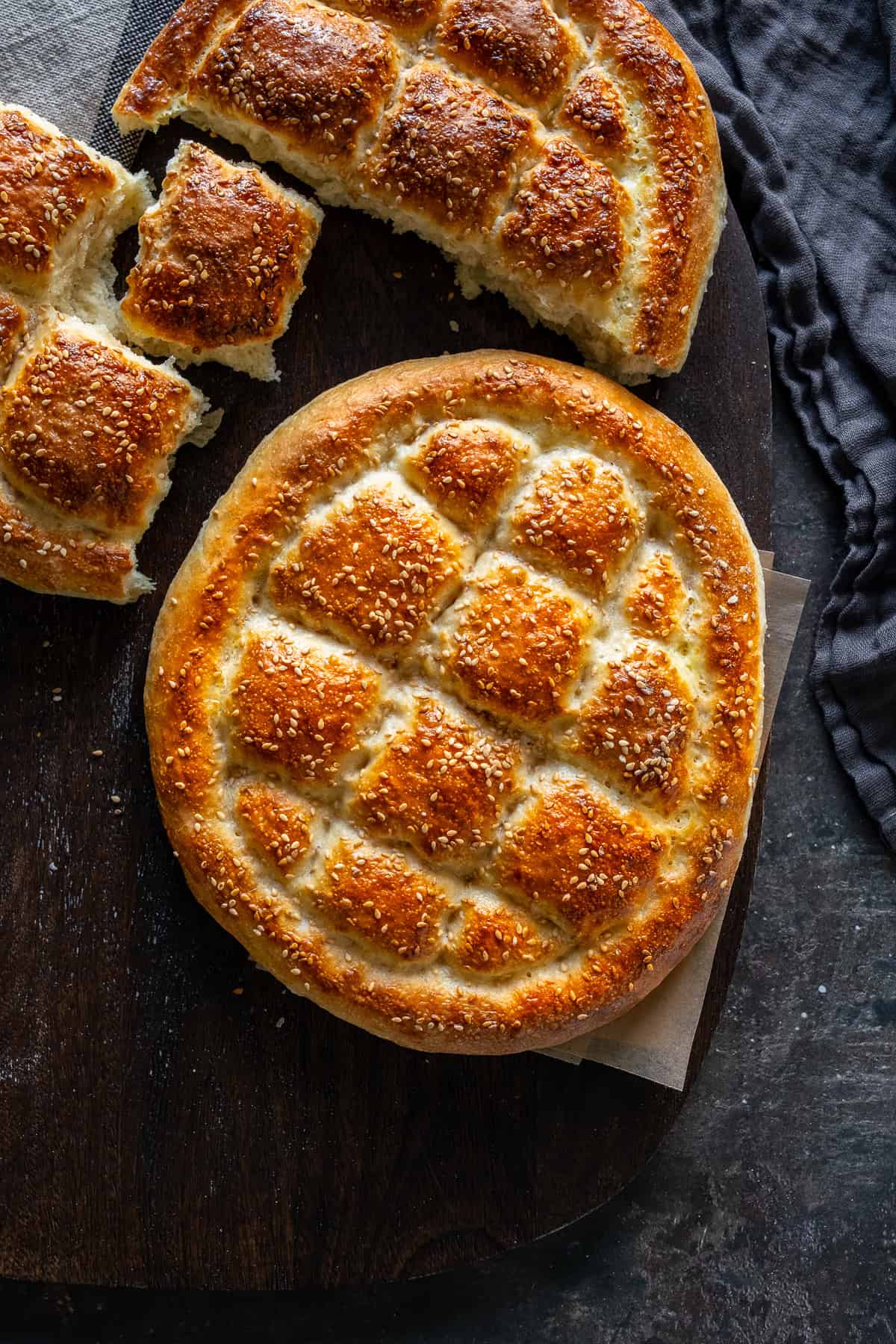
Pide Bread is the bread of our childhood, the one we waited in line for at the bakery. Still warm and fresh, it was impossible to resist sneaking a few bites on the way home.
Pide, the Bread of Ramadan
In Turkey, this special flatbread is known as pide bread (pide ekmek) or Ramadan pide (Ramazan pidesi).
It is called Ramazan pidesi because, in the past, bakeries made it only during Ramadan, the holy month for Muslims.
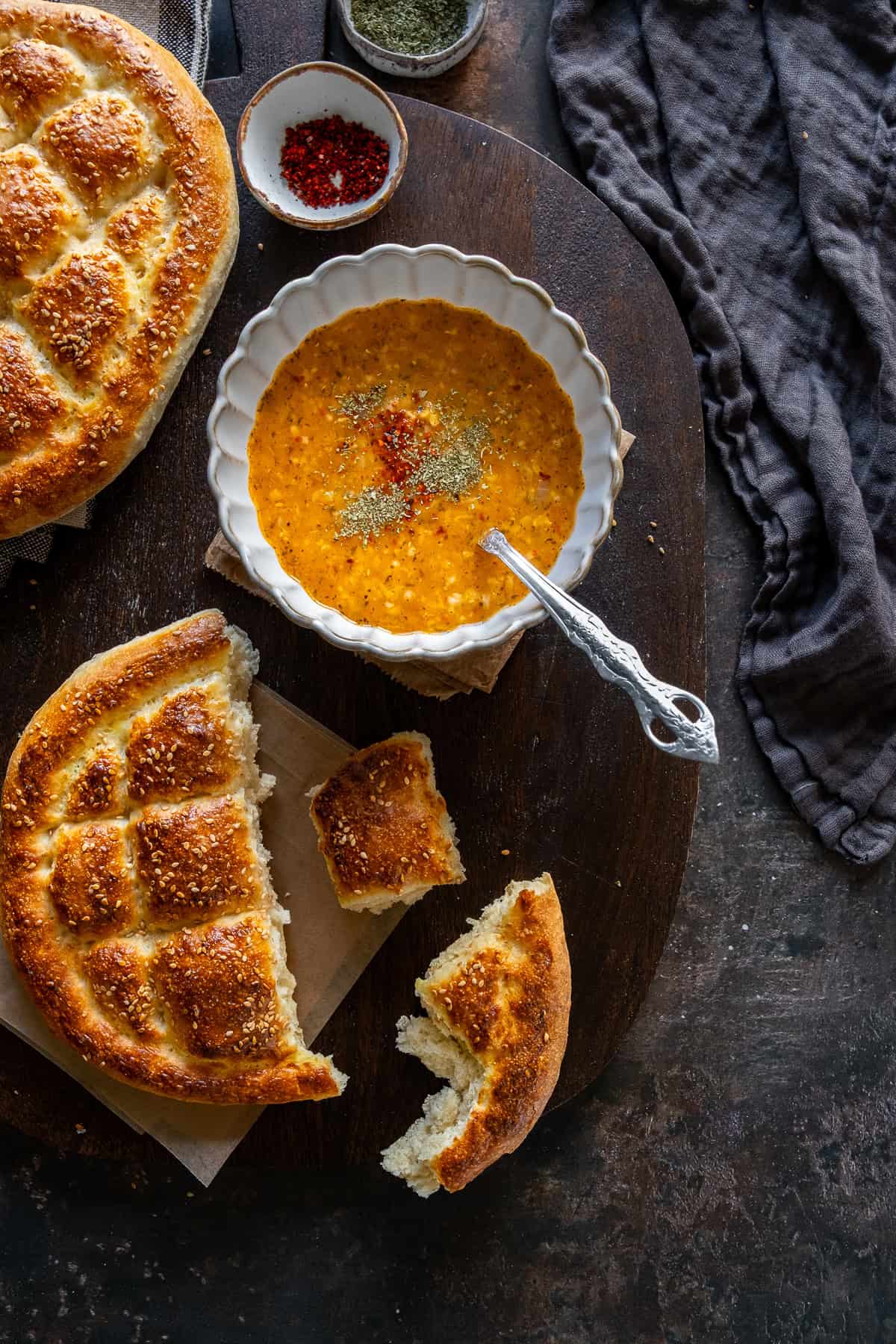
During the month of Ramadan, Muslims fast from early morning until dinner time, meaning they do not eat or drink anything during the day.
When it is time to break the fast at dinner, called iftar, it is a tradition to have freshly baked Ramazan pidesi on the table. It is often paired with a comforting soup like Ezogelin to start the meal.
Today, even though you can find pide bread in bakeries all year round, it is still a must-have at iftar tables during Ramadan. And after trying our recipe, you’ll see that you can easily make your own Turkish pide bread at home!
If you are interested in dishes for Ramadan, you should also check out the special dessert of this holy month called Güllaç!
About the Ingredients
The full list of ingredients and measurements is in the recipe card below.
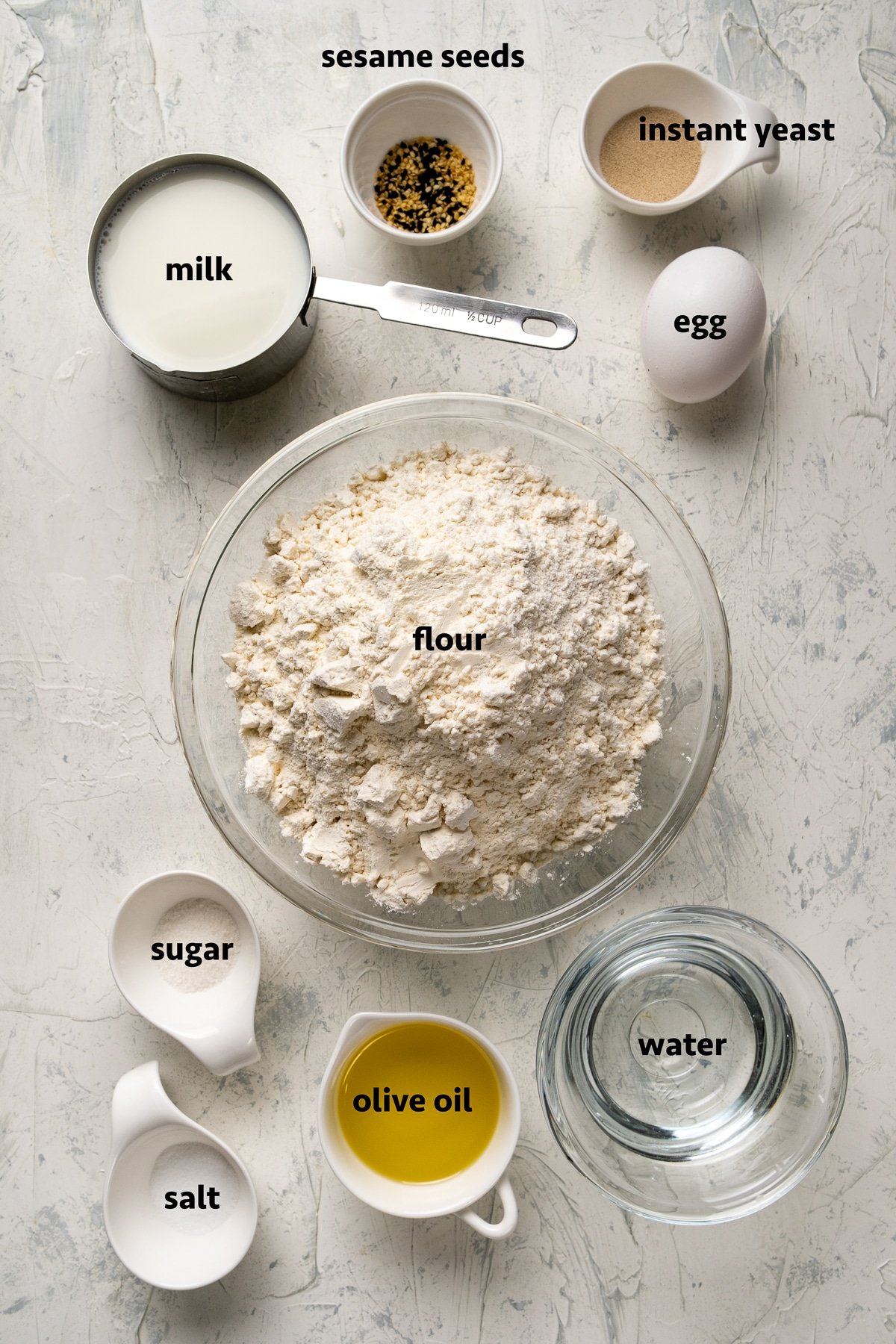
This Turkish pide bread recipe requires only a few simple ingredients:
- Flour: We recommend using all-purpose flour, but bread flour works well too.
- Sugar: Helps activate the yeast and balances the flavors.
- Instant yeast: Can be added directly to the mixture. If you use active dry yeast, first dissolve it in lukewarm water with sugar. Let it sit for about 5-10 minutes until foamy, then add it to the flour mixture.
- Olive oil: Improves the texture of the bread.
- Milk: Should be lukewarm to help activate the yeast.
- Water: Must also be lukewarm.
- Egg yolk and yogurt (or milk): Brushed on top to give the bread a rich golden color.
- Sesame seeds: Add crunch and flavor. Nigella seeds, or a combination of both, can also be used.
How to Make Turkish Pide Bread
The full instructions with exact measurements are in the recipe card below, but here’s a quick overview of the process.
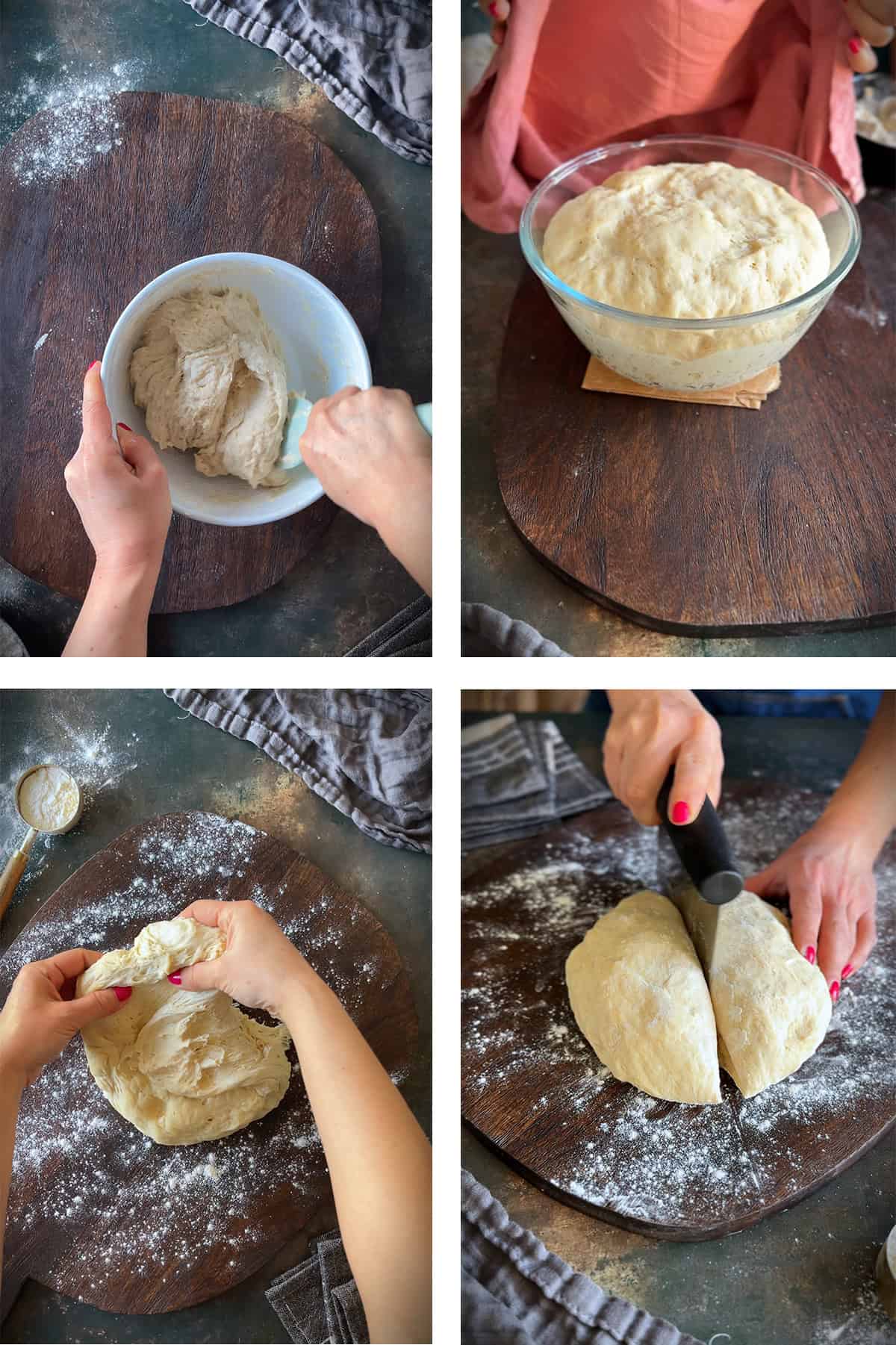
Start by mixing the dry ingredients in a large bowl. Add olive oil and lukewarm milk, then mix. Gradually pour in water while stirring until the dough comes together. Since it’s quite sticky, using a spatula instead of your hands makes this step easier.
Transfer the dough to an oiled bowl, cover it with a kitchen towel, and let it rise in a warm place until it doubles in size.
Once risen, place the dough on a floured surface and fold the edges to the center without kneading. Shape it into a ball and divide it into two equal pieces.
Flatten each dough ball on the baking sheet, shaping it into a round form. If the dough sticks, wet your fingers slightly.
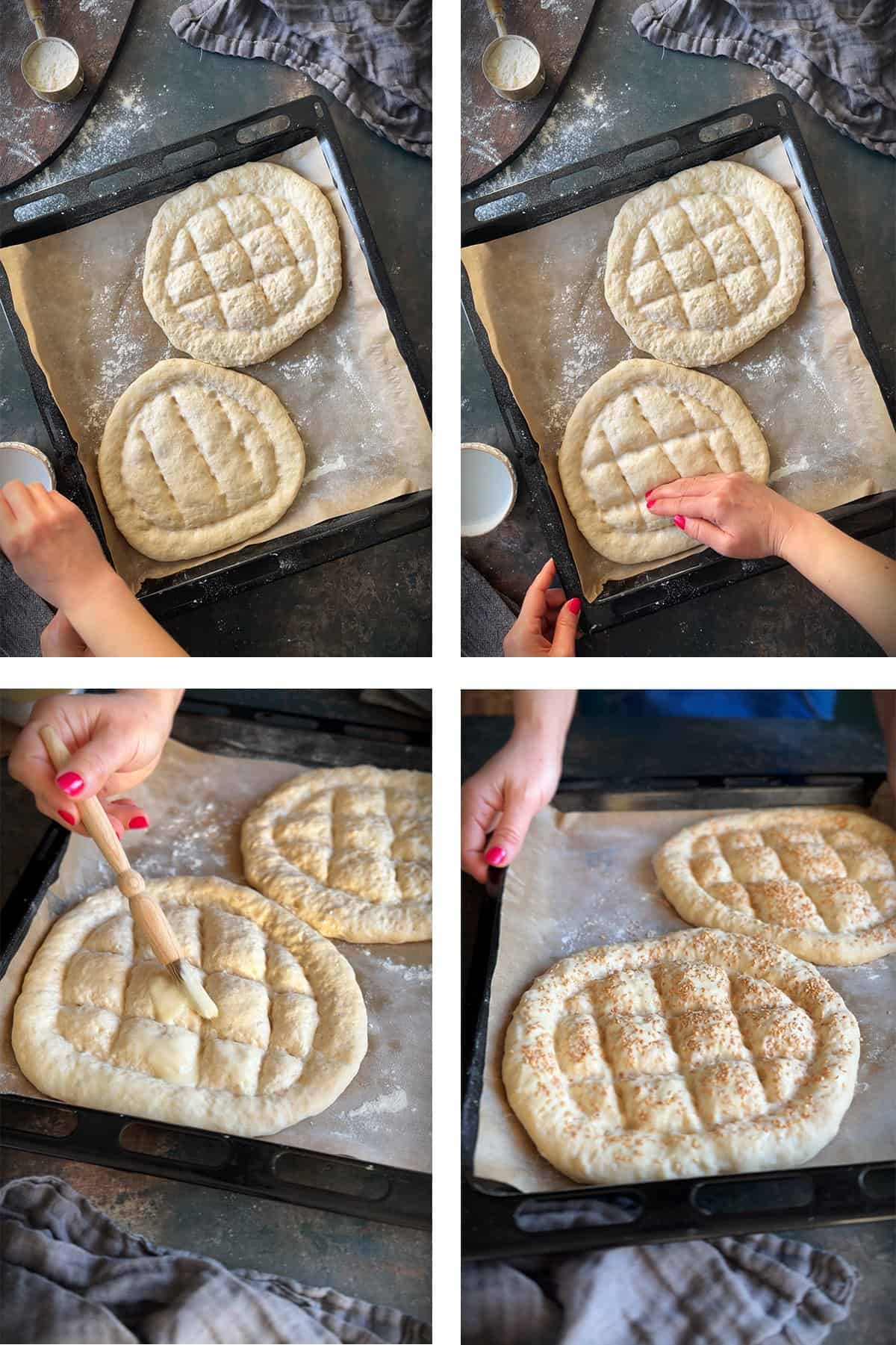
To make the traditional Turkish pide bread pattern, press deep indentations in a circular shape near the edge, then make vertical and horizontal indentations inside the circle.
Brush the top with a mixture of egg yolk and yogurt (or milk), then sprinkle sesame or nigella seeds. Let them rest for a second rise.
Before baking, press down on the indentations again to keep the pattern from disappearing. Bake until golden brown on top and firm at the bottom.
How to Make the Classic Pide Pattern
Creating the traditional pide bread pattern is simple.
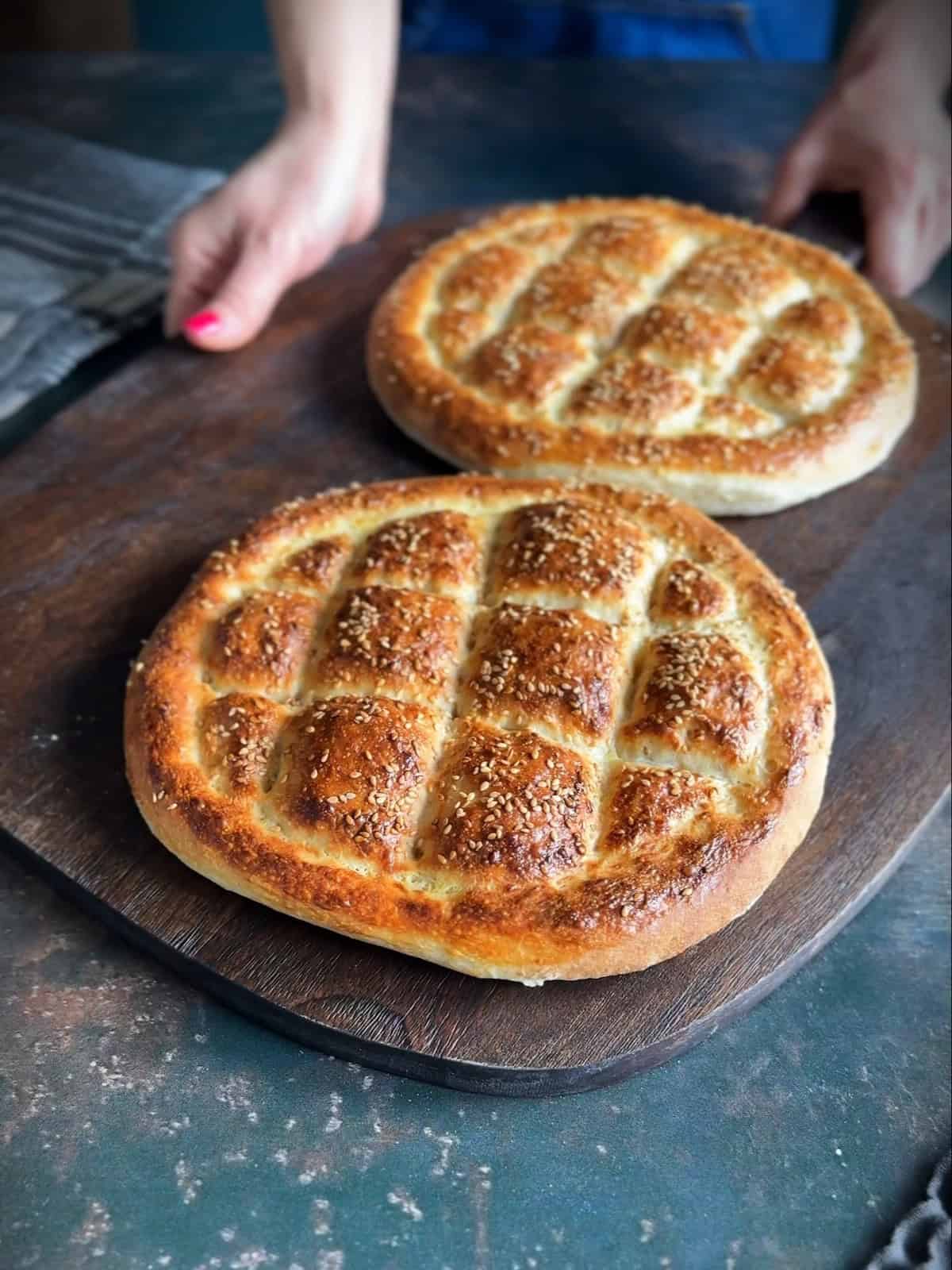
Here’s how we do it: After shaping the dough into a round or oval shape with your hands, wet your fingers slightly to prevent sticking and press a circular indentation about ½ inch (1.27 cm) from the edge to form a border. Inside this circle, make vertical and horizontal lines for the classic design.
Alternatively, you can use diagonal lines for a slightly different diamond pattern.
For the best results, make the pattern twice; once before the second rise and again just before baking.
Don’t hesitate to press firmly, as the dough will rise and soften the lines. This method ensures that the pattern stays visible after baking!
The Secret to Perfect Pide Bread: Steam!
The secret to getting bakery-style Turkish pide bread at home is creating steam in the oven.
To do this, place an oven-proof bowl or a small baking pan filled with water at the bottom of the oven before preheating. Let the oven heat up with the water inside so the steam builds up as it reaches the right temperature.
Make sure the bowl doesn’t block the lowest rack, as that’s where the baking sheet with the bread will go.
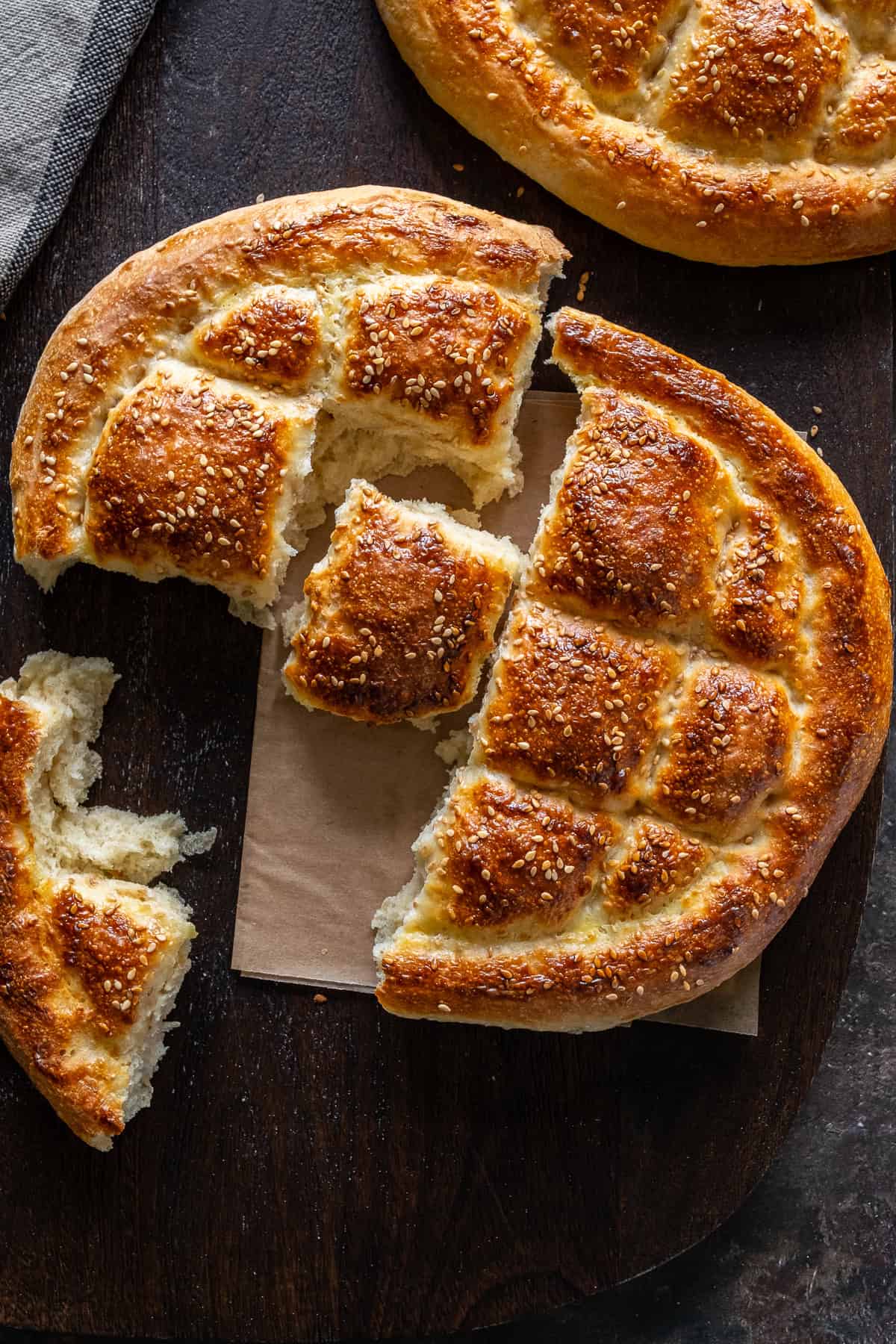
This simple step helps the pide develop a soft, airy inside while giving the top a slightly crispy finish, just like the ones from Turkish bakeries!
We used to bake pide bread without this important step, and while it still turned out delicious, the crust didn’t have that slightly crisp texture. That’s why we now highly recommend baking with steam for the best results.
Can I Make It One Large Loaf?
Yes, you can! Since it’s bigger, it may take a little longer to bake. After 15 minutes, check it. If it has a golden top but the bottom is still pale, lower the oven temperature to 325°F (165°C) and bake for another 2-3 minutes. Check again and repeat if needed. Be quick while checking to keep the oven heat stable.
Is Pide the Same as Pita?
No, they are different. Pide bread has a fluffy texture with a slightly crispy crust. Also, it has a diamond pattern on top. It doesn’t puff up to form a pocket like pita bread does.
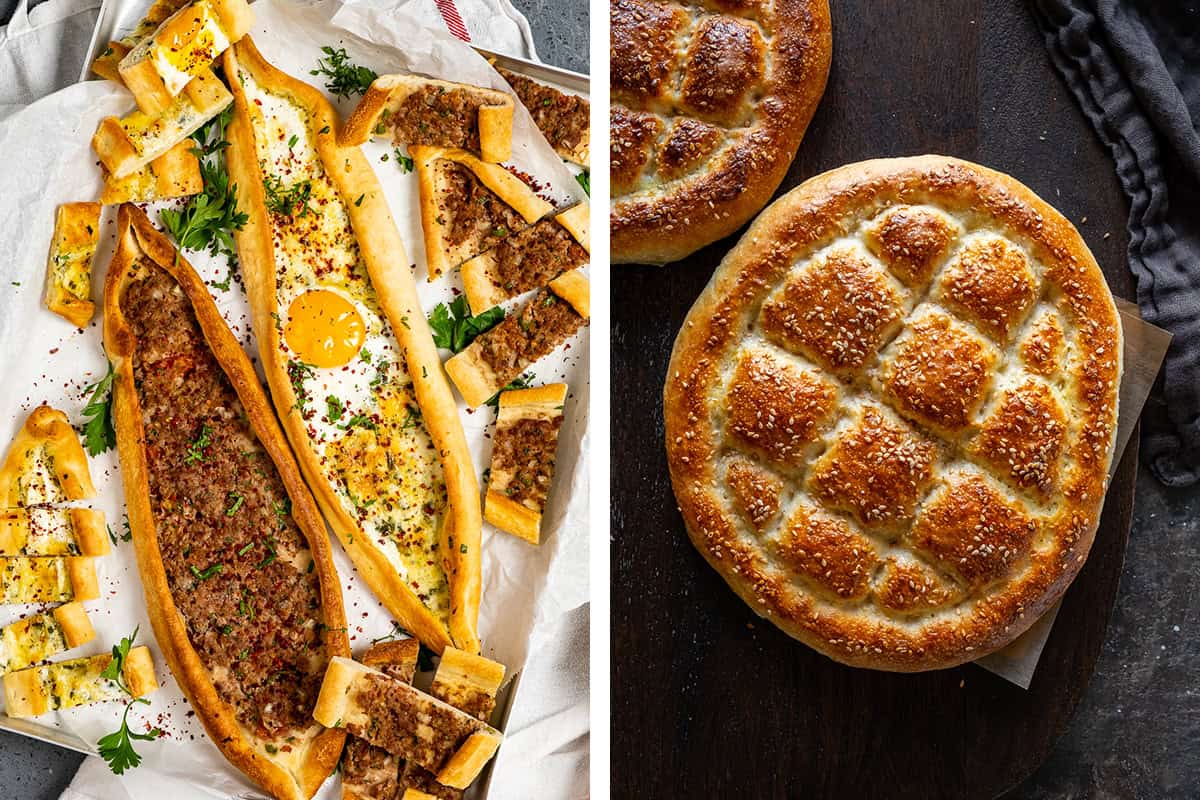
Pide vs. Pide Bread: What’s the Difference?
In Turkish cuisine, the word "pide" can refer to two different flatbreads.
Pide refers to a boat-shaped, pizza-like dish topped with ingredients like spinach, ground meat (kıymalı pide), cheese (peynirli pide). These are baked with their toppings, making them more of a main dish rather than a side like pide bread.
On the other hand, Pide bread (pide ekmeği) is a round (or oval), soft, and slightly crispy bread often served with meals, especially during Ramadan.
Serving Suggestions
Freshly baked pide bread is incredibly versatile and pairs well with many Turkish dishes. When it’s still warm, we love spreading butter on top and tucking some feta cheese inside for a simple yet delicious treat.
It’s a staple at a traditional Turkish breakfast table, served alongside olives, tomatoes, cucumbers, and jams.
Pide bread also makes the perfect side for Turkish kebabs like chicken shish kebab or Adana kebab. And if you’ve ever had İskender kebap, you know that the pide bread underneath soaks up the rich tomato sauce, making every bite extra flavorful.
Pide bread is also commonly served with soups such as Turkish lentil soup, tarhana soup, or Turkish tomato soup.
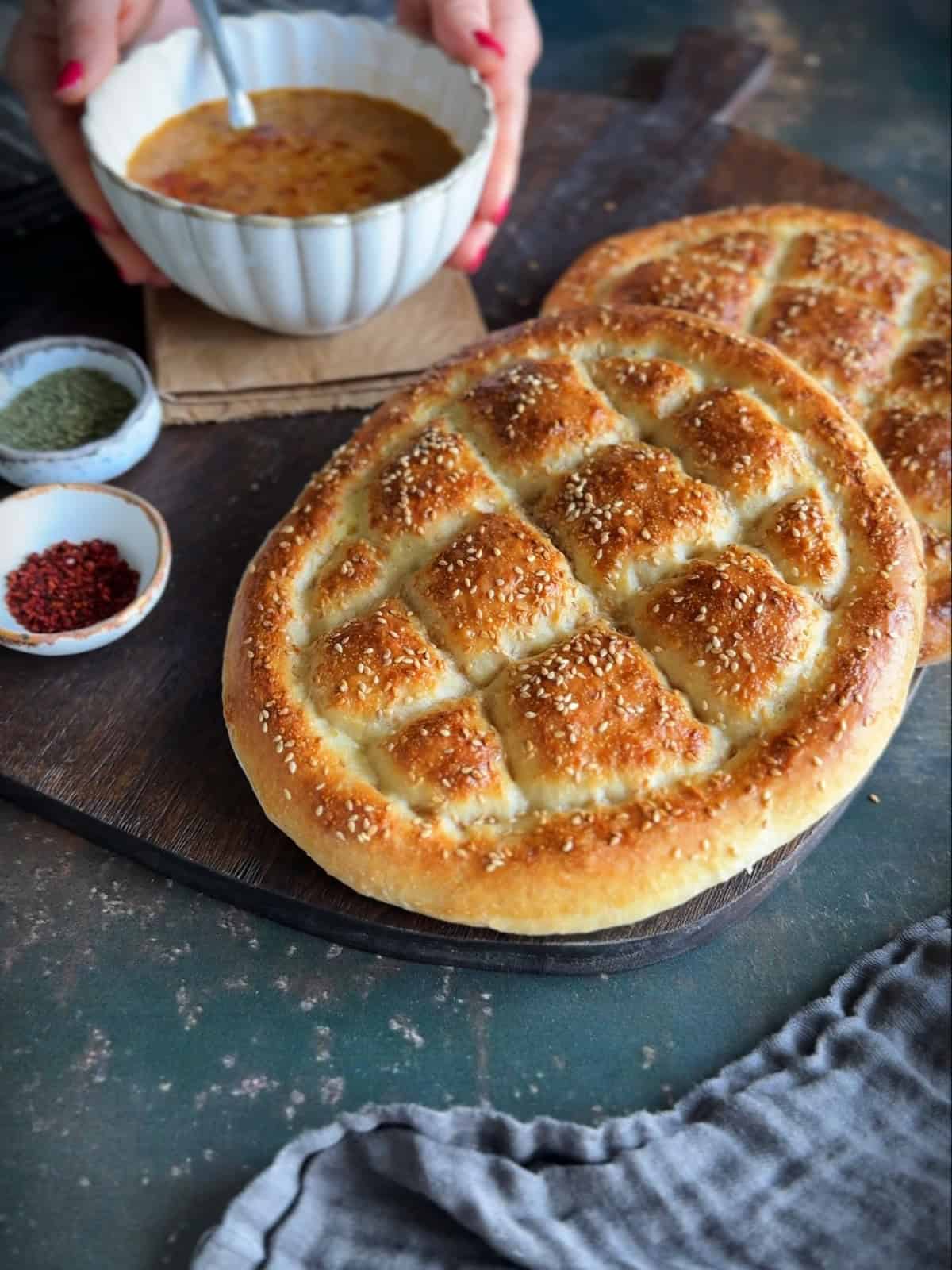
And if you want to pair it with mezes, go ahead! It’s great for scooping up creamy dips like haydari or spicy ezme.
Storage & Reheating
To keep Turkish pide bread fresh, store it in an airtight bag or container at room temperature for up to 3 days. For longer storage, wrap it well and freeze it for up to 3 months.
To reheat, simply warm it in a preheated oven at 350°F (175°C) for 5-7 minutes. If it’s frozen, let it thaw at room temperature first. You can also heat it in a dry pan over low heat or briefly in the microwave.
Can I Make It Ahead of Time?
Yes! If you want to prepare Turkish pide bread ahead of time, you can refrigerate the dough after the first rise.
Place it in a large enough bowl, as it will continue to rise slowly in the fridge. Cover it tightly and store it for up to 24 hours.
When you're ready to bake, take the dough out and let it sit at room temperature for about 30 minutes.
Then, shape, let it rise again, and bake as usual. This method allows you to have fresh pide bread with less prep time!
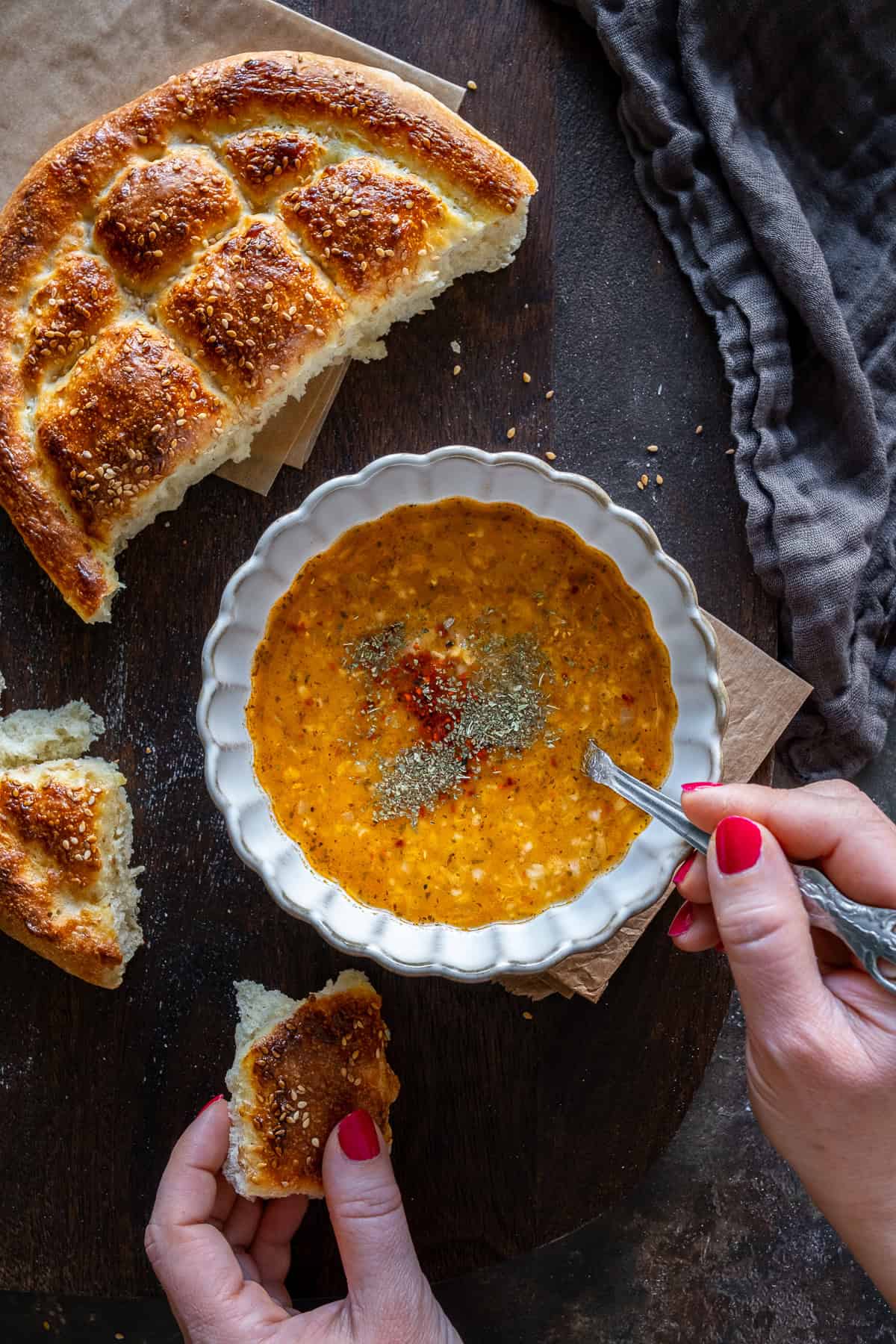
More Turkish Bread Recipes
- Biberli Ekmek (Turkish Pepper Bread)
- Turkish Cornbread
- Lavash Bread
- Bazlama
- Simit (Turkish Bagel)
- Gozleme
As always: If you make this recipe, let us know what you think by rating it and leaving a comment below. And post a pic on Instagram too—tag @give_recipe so we can see!
Sign up for the FREE GiveRecipe Newsletter to get the new recipes into your inbox! And stay in touch with us on Facebook, Pinterest, YouTube and Instagram for all the latest updates.
📖 Recipe

Turkish Pide Bread Recipe
INGREDIENTS
Dough:
- 420 g flour
- 1 teaspoon sugar
- 1 teaspoon salt
- 7 g dry instant yeast
- 25 ml olive oil
- 200 ml milk lukewarm
- 60 ml water lukewarm
Topping:
- 1 egg yolk
- 1 tablespoon yogurt
- 1 tablespoon sesame seeds or nigella seeds
INSTRUCTIONS
- In a large mixing bowl, whisk together the flour, sugar, salt, and instant yeast. Add the olive oil and lukewarm milk, then mix with a spatula. Gradually pour in the water while stirring until a sticky dough forms. A spatula works best for this step as the dough is quite sticky.
- Brush a separate large bowl with olive oil and transfer the dough into it. Cover with a clean kitchen towel and let it rest in a warm place until it doubles in size. This takes about 50-60 minutes in cooler weather or around 40 minutes on warmer days.
- Once the dough has risen, lightly flour your work surface and transfer the dough onto it. Fold the edges toward the center without kneading. Shape into a ball and divide it into two equal pieces.
- Line a baking sheet with parchment paper and sprinkle some flour on it. Place an oven-safe bowl filled with water at the bottom of the oven and preheat to 425°F (220°C).
- Place one dough ball on the prepared baking sheet and gently spread it out using your hands to about ½ inch (1.27 cm) thickness, forming a round shape. If the dough sticks, wet your fingers slightly.
- To create the traditional pide pattern, wet your fingertips and press firmly to make deep indentations. First, make a circular indentation about ½ inch (1.27 cm) from the edge. Then, create vertical and horizontal indentations inside the circle to form a diamond pattern. Repeat with the second dough ball.
- In a small bowl, whisk together the egg yolk and yogurt, then spread this mixture over the prepared breads using a brush or your hands. You might not need to use all of it and let the breads rest for a second rise, about 20 minutes. Sprinkle sesame seeds on each.
- Before baking, press down on the indentations again to reinforce the pattern. Place the baking sheet on the lowest rack of the oven and bake for 13-15 minutes, until the breads are golden on top and no longer pale at the bottom.
- Remove from the oven and cover the breads with a clean kitchen towel for 10 minutes. Then, transfer them to a cooling rack or another kitchen towel to cool completely.
- Serve warm for the best taste, or at room temperature.
Video
NOTES
- Steam for the Best Texture: Placing a bowl of water in the oven while preheating the oven and keeping it in the oven while baking helps create steam, resulting in a soft, fluffy interior and a slightly crispy crust.
- Press the Pattern Twice: To ensure the classic pide bread design holds after baking, press the indentations once before the second rise and again just before baking.
- No Kneading Needed: This dough is sticky, but that’s normal! Mixing with a spatula is enough to bring everything together.
- Storage Tips: Keep at room temperature for up to 2 days, refrigerate the dough for up to 24 hours before baking, or freeze the baked bread for up to 3 months.
- Nutrition Information: This is provided as a guideline only.
NUTRITION
Nutrition information is automatically calculated, so should only be used as an approximation.


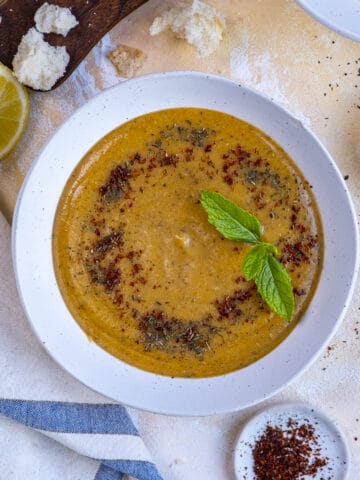

Unz says
This recipe worked really well and the product came out even better! Will be using the recipe again! So simple and easy to follow
Phil Dukoff-Gordon says
Hi. Its confusing about cups of flour into grams.
Your recipe for US units says ‘3 cup (420g) flour ‘
If I switch to metric units it reads ‘375 grams (420g) flour ‘
If I google '1 cup flour into grams' it says ‘One cup of all-purpose flour weighs 120 grams’
I make a lot of bread and the potential 60g range above will make a big difference to the hydration and crumb of the pide. What works for you in grams? I love the recipe though!
Zerrin & Yusuf says
Hi Phil,
Thanks for catching that and for your thoughtful feedback!
We normally use grams for dry ingredients, and for this pide bread recipe, we use 420g of flour. We’ve corrected the cup measurements in the recipe.
Glad you love the recipe. Hope you have a chance to try it soon. Cheers!
Gudrun Bender says
Just wanted to say thanks for your many interesting recipes! My sister's best friend back in the day of very young and into college was Zerrin (I think Oezdemir, but this is over 50 years ago now). Every time I see you I think of her!
Now I better try this recipe 🙂
Grace and peace to you!
Zerrin & Yusuf says
That’s such a lovely message, Gudrun! Thank you for your kind words. And what a beautiful connection!
We hope you love the recipe. Let us know how it turns out!
Grace and peace to you as well!
William Martin says
This an authentic recipe that has the soft pillowy inside of the Pide bread that I have had in restaurants. Note that the recipe doesn't tell you what to do with the sesame seeds but I put them on after I put the wash on.
Zerrin & Yusuf says
Hi William,
Thank you so much for this lovely comment and for the five-star rating! Glad you liked our pide bread recipe. And we've just added when to add the sesame seeds in the instructions. Thanks again!
A says
What kind of flour should I use? Do I use plain or bread flour?
Zerrin & Yusuf says
You can use all purpose plain flour.
Christine Murray says
Hi
I make this Turkish bread quite often. the advantage of this is that it can be eaten on the same day and is yummie.
The sourdough bread that I make is made one day and baked the next so takes much longer. I find shop bought sourdough is too hard on my teeth.
Chris.
Cat says
Made this today along with the Turkish rice, kapuska and Turkish lentil soup. All the above recipes were easy to follow but this one needs adjusting. You stated the the “total” cooking time was 40min when in fact the bread takes at least 1-2 hrs to rise (in a hot kitchen) and then another 20 min for the second rise (which is not stated in the recipe either. I am a decent cook but making the bread at the same time as the other dishes derailed the serving time due to the recipe not being clear.
Having said all this, it does end up tasting good, but unless you are Turkish and grew up watching your mama cooking Pide, you wouldn’t know what to look for and how long it all takes.
sevil sevdiyar says
Please confirm that 1 cup is 250ml as opposed to 200ml Turkish bardak.
I am thinking baking recipes would be better by weight rather than volume.
Zerrin & Yusuf says
Yes, our cup is 250 ml. You are right, giving the measurements by weight is definitely better. We try to add them as we update the recipes.
Maureen says
This bread, like every other bread you have shared, was so easy to make and came out so perfectly that my Turkish husband said it was as good as he's ever had. I even had nigella seeds that I bought in Turkey to sprinkle on top. It was puffy and tender inside and the outside had a perfect crispness. It is so delightful I will probably be making it throughout Ramadan. Thank you, once again, for a wonderful Turkish experience here in Berkeley, CA. Every time I see a new recipe from you in my inbox it lights up my morning.
Love from Maureen.
Zerrin & Yusuf says
Hi Maureen,
Your comment is music to our ears 🙂 Such a lovely review from your husband! And we are so happy to hear that you are enjoying the recipes we send in our newsletter.
Thank you for letting us know about these.
Cheers,
Zerrin & Yusuf
Lorraine says
Excellent recipe, bread was lovely. Will definitely make this again.
Zerrin & Yusuf says
Hi Lorraine,
Glad you liked it 🙂
Roe says
Hmmm, I couldn't get mine to rise. I set it in a bowl, covered it with a damp towel, and laid down with my toddler for an hour.
I used King Arthur's unbleached All-Purpose flour and sifted my cups into the bowl to make sure there was air. It's got to be my yeast. It's not instant, it's quick rise, brand new. I think I have to use another proofing method for that and then add it to the dough later.
If you have any recommendations for it, please do share, I'm going to throw this bad batch out and try again.
Zerrin & Yusuf says
Hi Roe,
Sorry to hear you didn't get the desired result. Not sure if the problem is about the yeast. Instant yeast and quick rise yeast work the same way.
Were water and milk lukewarm? If they are cold or hot, this will negatively effect the dough rising. Another thing that effects the rising is the room temperature. If it is not warm enough, the dough won't rise. So the best place to let it rest is inside the oven.
Claudia says
Such a unique bread recipe! Loved how you shaped it with your fingertips!